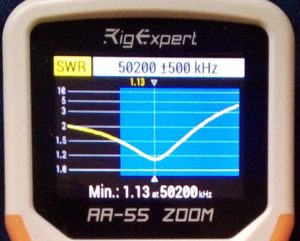Antennas for radio amateurs
Types of antennas for radio amateurs.
How RigExpert antenna analyzers help to optimize their performance.
Amateurs love to work with antennas – it’s an axiom that exists from the first days of ham radio.
Another axiom is that an amateur radio station is as effective as its antenna system.
There are many different types of antennas which fall into two categories:
- receiving antennas
- transmitting antennas
Receiving antennas are mainly used on low bands 160-80 meters due to high atmospheric and man-made noise. They are mainly aperiodic, like the Beverage antenna (invented by Dr. Harold Beverage in 1921), and are still widely used by amateurs around the world.

Dr. Harold H. Beverage
Other types of non-resonant receiving antennas are Flags, Pennants, small loops, arrays of short verticals, etc.
The resonant type is a small coaxial loop sometimes used in “fox-hunting” competitions.
RigExpert AA-35 ZOOM and AA-55 ZOOM can be used to check and adjust the impedance matching of these antennas.
Transmitting antennas, in the vast majority, are vertically or horizontally polarized. There are special circular polarized antennas for satellite VHF communications as well.
Vertical antennas are easy to install and are quite effective with an adequate ground system.
A lot of DXPeditions to remote islands are using this kind of antenna as the salt water is an excellent “ground” plane.
Guy Olinger K2AV has invented the Folded Counterpoise or FCP ( https://www.k2av.com/ ) – an effective alternative ground system for low-band vertical antennas.
Several companies manufacture multiband verticals, and to check the resonanсes and tune them the MultiSWR mode of RigExpert AA-35/55 ZOOM is an absolute necessity.
The arrays of phased verticals are widely used. The most common is “Four Square” or 4SQ invented by Dana Atchley W1CF and, again, RigExpert antenna analyzers are needed to tune these arrays.
There are a lot of varieties of horizontal antennas used by amateurs that include:
- wire antennas
- monoband and multiband multielement directional Beam or Yagi antennas
- directional Quad antennas
- Log Periodic or LPDA arrays
- other

Hidetsugu Yagi, the Inventor
Wire antennas are easy to build and can be quite effective for daily work. They are monoband or multiband like Frietzel FD4. In any case, tuning wire antennas to resonance using RigExpert AA-35 ZOOM and AA-55 ZOOM will guarantee the optimum antenna performance.
If an amateur decides to make the directional array himself, the first step is to find the antenna model prototype or design the model personally. There are a lot of antenna modeling software for amateurs based on Numerical Electromagnetics Code, or NEC developed at the Lawrence Livermore National Laboratory both for Windows and Linux OS free of charge like:
- EZNEC by W7EL
- MMANA by JE3HHT
- Yagi Optimizer by K6STI
When the needed antenna prototype is found or own antenna model is developed, it’s time to get the necessary materials and make the proper mechanical design for the antenna to withstand high winds.
For instance, there’s an excellent book “Physical Design of Yagi Antennas” by David B. Leeson W6QHS (ISBN-0-87259-381-9), describing how to design Yagi antennas to handle up to 140 mi/h winds.
There’s a lot of information on this subject for wire and quad antennas available from different sources as well.
Finally, the antenna has been built, and it’s time to check how the real antenna parameters correspond to the calculated model.
So it’s time to switch the RigExpert AA-XX antenna analyzer ON, check the SWR, impedances, etc., and tune the antenna to the designed frequency band.

RigExpert AA-55 ZOOM
For wire antennas, this will require trimming the wires to tune to resonance. The design and tuning of wire antennas are described in the useful book “73 Dipole and Long-Wire Antennas” by Edward M. Noll W3HQJ (Library of Congress catalog card number 72-81301).
Checking and tuning directional antennas both for HF and VHF is a bit more complicated.
The antenna under test has to be at least ½ wave up from the ground. The rope and pulley are ideal for lifting and lowering it to check the parameters using the RigExpert AA-XX Antenna and cable analyzer.
The choice of the analyzer depends on the frequencies amateur is using.
If he works on HF only, the RigExpert AA-35 ZOOM Antenna and Cable analyzer is the proper choice.
If, additionally, 50 MHz is of some interest, the RigExpert AA-55 ZOOM VNA is an ideal solution.
For VHF (144 MHz and higher) RigExpert AA-230 ZOOM and other VHF/UHF “RigExpert AA-XXX ZOOM” and “Stick” models are needed.
With the RigExpert antenna analyzers, the process of tuning directional antenna is simple and easy.
- For a monoband antenna, connect the piece of coaxial feedline that equals electrical ½ wave to the driven element. This will allow the analyzer to “see” the antenna input impedance.
- Go to the “SWR Chart” analyzer’s option and press OK. The SWR curve and the resonant frequency will be displayed.
- If the resonant frequency is close to the calculated one, the antenna can go up to the tower for stationary operation
- If the resonant frequency is different from the calculated one, all elements must be shortened or extended equally. For instance, shortening all elements of the 6m Yagi antenna for 1cm or 0.33% will move the SWR curve up approximately 160 KHz.
- Remember. Never try to get to resonance by just changing the driven element length.
For checking the resonances of the multiband antennas, use the “MULTI SWR” option of RigExpert antenna analyzers connecting them at the transmitter end of the coaxial feed line.

